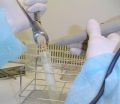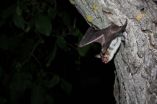(Press-News.org) A new study in East Asian women has identified three genetic changes linked to an increased risk of breast cancer. The research, led by Vanderbilt University investigators, was published online July 20 in Nature Genetics.
While breast cancer is one of the most common malignancies among women worldwide, most studies of the genetic risk factors for the disease have focused on women of European ancestry.
Given the differences in genetic heritage and environmental exposures between East Asian women and those of European ancestry, the investigators decided to conduct a study in East Asians to search for genetic changes that are linked to breast cancer development. The current study was conducted as part of the Asia Breast Cancer Consortium led by Wei Zheng, M.D., Ph.D., MPH, Ingram Professor of Cancer Research at Vanderbilt.
First author Qiuyin Cai, M.D., Ph.D., associate professor of Medicine, and colleagues performed a genome-wide association study of 22,780 women with breast cancer, and 24,181 control subjects who were recruited in 14 studies in Asian countries, including China, Japan, Korea, Malaysia and Singapore.
DNA for the gene assays was obtained through blood samples or buccal cells from mouthwash.
"We found DNA sequence changes in two genes, PRC1 and ZC3H11A, and a change near the ARRDC3 gene were associated with breast cancer risk and we identified a possible association with a fourth gene locus," said Cai. "Two of those sequence changes are in parts of the genome that regulate the expression of nearby genes."
ARRDC3 and PRC1 genes were previously linked to breast cancer growth and poor survival in breast cancer patients, respectively. The role of ZC3H11A in breast cancer is unknown.
These DNA sequence changes may affect the regulation of cell growth, tumor cell migration and invasion, or metastasis.
These results were also replicated in a large consortium, including 16,003 breast cancer cases and 41,335 control subjects of European ancestry, as reported by the authors.
The risk of breast cancer conferred by each of these new genetic markers is relatively small. However, these new markers could be combined in the future with other breast cancer predictors, including genetic markers identified previously, to identify potentially high-risk women for screening and other prevention programs.
Results from this study provide additional insights into the genetics and biology of breast cancer. Based on these findings, the authors say further studies of possible mechanisms through which these loci and genes are involved in breast cancer development are warranted.
INFORMATION:
Other Vanderbilt investigators involved in the study include Ben Zhang, M.D., Ph.D., MPH, Jiajun Shi, Ph.D., Jirong Long, Ph.D., Wanqing Wen, M.D., MPH, Ryan Delahanty, Ph.D., Yanfeng Zhang, Ph.D., Bingshan Li, Ph.D., Chun Li, Ph.D., Xiao Ou Shu, M.D., Ph.D., MPH, and Wei Zheng, M.D., Ph.D., MPH.
The Vanderbilt-led research was primarily funded by the U.S. National Institutes of Health (R01CA124558, R01CA148667, R37CA070867, R01CA118229, R01CA092585, R01CA064277, R01CA122756, and R01CA137013); Department of Defense Idea Awards (BC011118 and BC050791); and Vanderbilt-Ingram Cancer Center, (Ingram Professorship).
Vanderbilt-led study identifies genes linked to breast cancer in East Asian women
2014-07-23
ELSE PRESS RELEASES FROM THIS DATE:
Scientists find way to maintain quantum entanglement in amplified signals
2014-07-23
Physicists Sergei Filippov (MIPT and Russian Quantum Center at Skolkovo) and Mario Ziman (Masaryk University in Brno, Czech Republic, and the Institute of Physics in Bratislava, Slovakia) have found a way to preserve quantum entanglement of particles passing through an amplifier and, conversely, when transmitting a signal over long distances. Details are provided in an article published in the journal Physical Review A (see preprint).
Quantum entangled particles are considered to be the basis of several promising technologies, including quantum computers and communication ...
Obesity linked to low endurance, increased fatigue in the workplace
2014-07-23
FALLS CHURCH, Va. -- U.S. workplaces may need to consider innovative methods to prevent fatigue from developing in employees who are obese. Based on results from a new study published in the Journal of Occupational and Environmental Hygiene (JOEH), workers who are obese may have significantly shorter endurance times when performing workplace tasks, compared with their non-obese counterparts.
The study, conducted at Virginia Tech in Blacksburg, Va., examined the endurance of 32 individuals in four categories (non-obese young, obese young, non-obese older, and obese older) ...
The electric slide dance of DNA knots
2014-07-23
DNA has the nasty habit of getting tangled and forming knots. Scientists study these knots to understand their function and learn how to disentangle them (e.g. useful for gene sequencing techniques). Cristian Micheletti, professor at the International School for Advanced Studies (SISSA) in Trieste and his team have been carrying out research in which they simulate these knots and their dynamics. In their latest paper, just published in the journal Soft Matter, Micheletti together with Marco Di Stefano, first author and PhD student at SISSA, and colleagues from Ljubljana ...
Ancient genetic material from caries bacterium obtained for the first time
2014-07-23
Streptococcus mutans, one of the principal bacteria that cause dental caries, has increased the change in its genetic material over time, possibly coinciding with dietary change linked to the expansion of humanity. This is highlighted in a study by researchers from the Universitat Autònoma de Barcelona (UAB) and the Laboratorio Nacional de Genómica para la Biodiversidad (National Laboratory of Genomics for Biodiversity) in Mexico who, for the first time, have sequenced genetic material from this bacterium in populations from the past. Increase in genetic diversity has ...
Linking television and the Internet
2014-07-23
The panel discussion is getting heated -- but what exactly is in the new proposed law that the experts on TV are arguing about so vigorously? Up until now, spontaneous questions such as these that arise during a program had to be clarified through a viewer's own research on the Internet.
If it's up to researchers at the Fraunhofer Institute for Intelligent Analysis and Information Systems IAIS in Sankt Augustin, Germany, viewers will no longer have to look up such additional information in the future. In the project "LinkedTV", the institute is working with eleven partners ...
Bats use the evening sky's polarization pattern for orientation
2014-07-23
This news release is available in German.
Animals can use varying sensory modalities for orientation, some of which might be very different from ours. Some bird species for example take the polarization pattern produced by sunlight in the atmosphere to calibrate their orientation systems. Now researchers from the Max Planck Institute for Ornithology in Seewiesen, Germany, and Queen's University Belfast have discovered with colleagues from Israel that a night active mammal, the greater mouse-eared bat, has the capability to orient using polarized light. These bats ...
Rising temperatures hinder Indian wheat production
2014-07-23
Geographers at the University of Southampton have found a link between increasing average temperatures in India and a reduction in wheat production.
Researchers Dr John Duncan, Dr Jadu Dash and Professor Pete Atkinson have shown that recent warmer temperatures in the country's major wheat belt are having a negative effect on crop yield. More specifically, they found a rise in nighttime temperatures is having the most impact.
Dr Jadu Dash comments: "Our findings highlight the vulnerability of India's wheat production system to temperature rise, which is predicted to ...
A crystal wedding in the nanocosmos
2014-07-23
Researchers at the Helmholtz-Zentrum Dresden-Rossendorf (HZDR), the Vienna University of Technology and the Maria Curie-Skłodowska University Lublin have succeeded in embedding nearly perfect semiconductor crystals into a silicon nanowire. With this new method of producing hybrid nanowires, very fast and multi-functional processing units can be accommodated on a single chip in the future. The research results will be published in the journal Nano Research.
Nano-optoelectronics are considered the cornerstone of future chip technology, but the research faces major ...
Intestinal parasites are 'old friends,' researchers argue
2014-07-23
Intestinal parasites such as tapeworms, hookworms and a protist called Blastocystis can be beneficial to human health, according to a new paper that argues we should rethink our views of organisms that live off the human body.
To prove the point, paper co-author Julius Lukeš even ingested three developmental stages of a large species of tapeworm called Diphyllobothrium latum. After more than a year with the tapeworms, which might have grown to be as long as four metres each by now, he says he feels fine.
"I knew there was no risk," he says.
Lukeš, a senior fellow ...
Toward an oral therapy for treating Alzheimer's disease: Using a cancer drug
2014-07-23
Currently, no cure exists for Alzheimer's disease, the devastating neurological disease affecting more than 5 million Americans. But scientists are now reporting new progress on a set of compounds, initially developed for cancer treatment, that shows promise as a potential oral therapy for Alzheimer's. Their study appears in ACS' Journal of Medicinal Chemistry.
Carlo Ballatore, Kurt R. Brunden and colleagues explain that in a healthy brain, the protein known as tau binds to and stabilizes microtubules, which are cellular components made of protein inside cells. Microtubules ...






